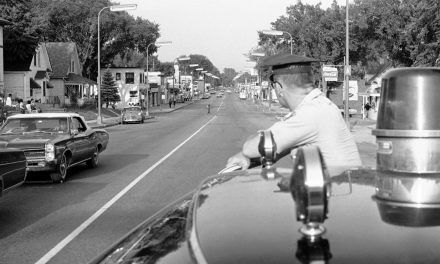
Wisconsin marked its 170th anniversary of statehood on May 29, 2018.
To understand the state’s relationship to federal law and national government, legal scholar Joseph Ranney says it is necessary to look back decades earlier, to a point in United States history when the Constitution was still being drafted with the adoption of the Northwest Ordinance.
“The Northwest Ordinance is arguably the most important law passed that affects Wisconsin,” Ranney said. Ranney is a lawyer and visiting professor at the Marquette University Law School and the author of many books, including Wisconsin and the Shaping of American Law, published by the University of Wisconsin Press in 2017. “The Ordinance is a fundamentally important part of Wisconsin’s heritage. It’s really embedded in our state DNA and we take great pride in it today,” Ranney said.
The Second Continental Congress passed the Northwest Ordinance in 1787 as a way to establish new states in territory the United States had gained northwest of the Ohio River after the Revolutionary War. It authorized a provisional territorial government, provided for the creation of new governments within those territories, created a bill of rights for residents and prohibited slavery, and created a way to survey land and sell it to new settlers.
It was a “unique colonial structure” that the Wisconsin Supreme Court that would use in 1854 to defy a federal law requiring northern states to cooperate with federal law-enforcement officials in returning escaped slaves to their southern holders, Ranney said.
From the the rights of runaway slaves in to the modern debate over school vouchers, Wisconsin has played a significant role in shaping American law. In his interview on University of the Air, Ranney identified five state Supreme Court cases that stand out for their role in shaping Wisconsin’s law and identity throughout its history.
Ableman v. Booth, 1854
In 1854, Sherman M. Booth, editor of the Milwaukee abolitionist newspaper The Free Democrat, was arrested for violating the Fugitive Slave Act of 1850. Booth had raised a mob to rescue an escaped slave named Joshua Glover from jail after federal marshals tracked him down in Racine, where he worked in a sawmill.
Booth was released on bail, but he surrendered to federal authorities two months later, in hopes of bringing a test case against the fugitive slave law. Booth’s attorney, Byron Paine — who would later become a Wisconsin Supreme Court justice — succeeded in getting a hearing before the state’s highest court. Among other things, Paine argued that the law was unconstitutional because it denied the right to a jury trial, and that states had the right to step in when their sovereign rights were violated by the federal government.
That argument won the day.
At its core, Ableman v. Booth (also known as the “Booth case”) was a battle over slavery and state’s rights, Ranney said. While there were challenges to the Fugitive Slave Act in other states, the Wisconsin Supreme Court stood alone when it declared the law unconstitutional in 1854.
Five years later, in 1859, the U.S. Supreme Court unanimously reversed the Wisconsin Supreme Court decision in an appeal. When Chief Justice Roger Taney, author of the infamous Dred Scott decision denying U.S. citizenship rights to African Americans, handed down the opinion, the Wisconsin justices voted not to certify the decision or abide by it.
The debate was not fully resolved until the Civil War made the whole issue moot, Ranney said. Congress repealed the Fugitive Slave Act in 1864.
“During the Civil War the relationship between the federal government and state governments was transformed. The federal government grew tremendously. They had to create a huge standing army to fight the war, they had to transform the financial system in order to finance the war. With victory, the federal government was permanently acknowledged as being the most powerful government in the country,” Ranney said.
But in Wisconsin, states’ rights battles didn’t completely end with the Civil War, Ranney said. Over the following decade, the state Supreme Court tried to strike down several U.S. laws that had expanded federal courts’ jurisdiction after the war at the expense of the states, he said.
“In the early 1870s, several of those cases were appealed, and the U.S. Supreme Court ruled definitively that, no, the U.S. Supreme Court has the final say as to the constitutionality of federal and state laws under the federal Constitution,” Ranney said.
Bashford v. Barstow, 1856
Another highly political case in the first decade of the state’s existence established the independence and authority of the Wisconsin Supreme Court, which was still quite new at the time.
Democratic incumbent Gov. William Barstow had been certified as the winner of the 1855 election over Republican challenger Coles Bashford. Republicans appealed the decision to the state Supreme Court, charging that a few precincts in Eau Claire and Chippewa counties had falsified results.
“The incumbent argued that ‘the court can’t tell me what to do. I’m the head of the executive branch, I get to decide who is the head of the executive branch'” Ranney said.
As the incumbent Barstow held a full public inauguration on Jan. 7, 1856, Bashford had a private swearing-in ceremony in a justice’s chambers at the Wisconsin Supreme Court. Barstow resigned as governor amidst the legal proceedings against him, and the Supreme Court awarded the office to Bashford on March 24, 1856.
The justices had to answer to people who thought that the Wisconsin Supreme Court was a political body and establish the court’s authority at the same time. To do that, they used what Ranney called a “very clever rhetorical trick.”
“The court said essentially that ‘we are just interpreters of the state constitution. We’re not political, but our duty interpreting the state constitution is to say we have the power to decide who’s the governor here,'” he said. “They did. The incumbent lost, and since that time it’s universally accepted as the body that has the final say in Wisconsin. That case established that principle.”
Attorney General v. Chicago & Northwestern Railroad Company, 1874
By 1874, railroad companies had become very powerful in Wisconsin. The Chicago, Milwaukee & St. Paul and the Chicago & Northwestern companies were “dominating state politics as well as state transportation,” Ranney said.
Concern grew that the railroads were charging exorbitant rates and were discriminating against certain regions of the state. When reformers gained control of government in the early 1870s, the legislature enacted a law fixing maximum freight rates and passenger fares the companies could charge. It became known as the “Potter Law,” named for its sponsor, Sen. Robert L.D. Potter of Waushara County.
The law was challenged, but in a strongly worded opinion, Edward Ryan, the court’s chief justice and an appointee of the reform Gov. William R. Taylor, upheld its requirements. He wrote that the state must preserve its right to control “great corporations [which were] independent powers within the states … baffling state order, state economy, state policy.”
This case established in Wisconsin that the government has the power to regulate corporate activity. It laid the foundation for the modern regulatory state, which the Progressives built upon, Ranney said.
State v. Lange Canning Co., 1916
The Wisconsin Supreme Court upheld many reform laws of the early 20th century, but Ranney said this case was most important among them.
The Court initially ruled that a part of the law authorizing the Wisconsin Industrial Commission to impose limits on women’s working hours was unconstitutional because it “impermissibly delegated legislative power to another body,” Ranney wrote in an article for Wisconsin Lawyer.
But Attorney General Walter Owen, who would become a state Supreme Court justice two years later, asked the court to reconsider. The justices excused themselves into a conference room.
“We’ll never know exactly what happened in that conference room, but in the end they come out and reverse themselves. Chief Justice [John B. Winslow], who dissented the first time around, apparently persuaded his colleagues to uphold the law as constitutional,” Ranney said.
The ruling preserved the ability of government to delegate the details of policy-making to administrative agencies, and perhaps more than any other case, it was the key to saving the legacy of Progressive-era reform, he said.
“Ironically we’re starting to see in this day and age a bit of backtracking from that. There’s now a very lively debate going on in both in the U.S. Supreme Court and our Supreme Court as to how far agencies should be allowed to go in rulemaking and how far courts have to defer to rules that agencies make,” Ranney said. “Once again, issues in the law are never permanently resolved. Everything old ultimately becomes new again.”
Davis v. Grover, 1992
In Davis v. Grover, the Wisconsin Supreme Court decision upheld the Milwaukee Parental Choice Program, a 1990 school voucher law that allowed the use of state tax money to send a select number of low-income children to private schools. Wisconsin was the first state in the country to enact such a law.
“To me it’s emblematic of some of the trends in modern law and modern Wisconsin legal history,” Ranney said.
“Since the social revolutions of the 1960s, there’s been a fundamental transformation in American consciousness of what the scope of individual rights should be. Prior to the 1960s, we were a much more communitarian society than we are now. People talked to each other more, people shared a consensus of values more, but the downside to that was there was a sort of invisible, but nevertheless real, boundary over what constituted acceptable political discourse,” Ranney said.
Starting in the 1960s, that starts to change, he said. “There’s a movement toward what legal scholars call ‘expressive individualism,’ or to use the ’60s phrase, ‘the freedom to do your own thing,'” he said. “We think of it as a liberal doctrine, but it has been used by both sides of the political divide.”
By the late 1980s, people in Wisconsin and elsewhere had begun to doubt the effectiveness of school integration. The 1990 law effectively empowered parents to use state dollars to make individual choices about where their children go to school, Ranney said.
“This was really the first time that the Wisconsin Supreme Court had put its stamp of approval on expressive individualism,” he said. “The Court was very badly divided. If you read the majority and dissenting opinions, there’s a lot of political discussion and bitter, vehement language.”
The Wisconsin Supreme Court voted 4-3 to uphold the law. The U.S. Supreme Court declined to hear the case on appeal, but upheld a similar law from Ohio in 2002 (in Zelman v. Simmons-Harris). In 2018, Wisconsin is spending nearly $267 million dollars a year on school choice programs, about three percent of its total spending on K-12 education, according to an analysis by the pro-voucher think tank EdChoice. Meanwhile, school vouchers remain a divisive issue, more than 25 years on from their creation in Wisconsin.
“Courts make decisions that matter to people’s lives. They exercise a great deal of power and anytime you have a body exercising power that hurts some people and helps others, that’s going to be politically controversial,” Ranney said.













